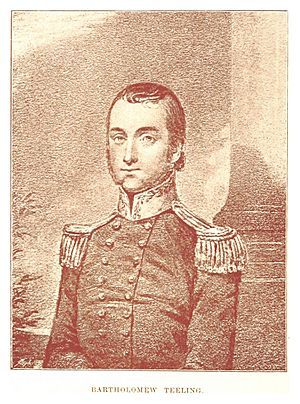Bartholomew Teeling facts for kids
Bartholomew Teeling (born around 1774 – died 24 September 1798) was an Irish leader and soldier. He played a big part in the Irish Rebellion of 1798. He was known for a brave act during the Battle of Collooney. Teeling was captured at the Battle of Ballinamuck and later put to death for his actions.
Contents
Who Was Bartholomew Teeling?
Bartholomew Teeling was born around 1774 in Lisburn, County Antrim. His father was a rich linen maker. Bartholomew went to school in Lisburn. His younger brother, Charles, later became a writer.
In 1795, Bartholomew and Charles joined a group called the Society of United Irishmen. They helped this group work with another group called the Defenders. Their brother-in-law, John Magennis, was a leader of the Defenders in County Down. In 1796, Bartholomew traveled to France. He went there to ask France to help Ireland.
The Rebellion Begins
In 1798, the Irish Rebellion of 1798 started. This was a fight against British control over Ireland. Teeling came back to Ireland on August 22, 1798. He was a helper to General Jean Humbert. They landed at Killala Bay with French soldiers. This was between County Sligo and Mayo.
On August 28, Humbert's men captured Castlebar. The United Irishmen then set up a new government. They called it the Republic of Connacht. The French and Irish forces moved east. They went through County Sligo. But they were stopped by a cannon. British forces had placed it near Collooney.
Teeling's Brave Act at Collooney
On September 5, 1798, Teeling fought in the Battle of Collooney. He helped the Irish and French win. He did this by stopping the cannon all by himself. He rode fast towards the enemy with a pistol. Teeling stopped the person using the cannon and took control of it.
This allowed the Irish and French forces to move forward. Their opponents had to go back to their barracks in Sligo. They lost 60 men and 100 were captured.
The Final Battle and Teeling's Fate
The Battle of Ballinamuck was fought near Longford. Teeling and about 500 other Irishmen were captured there. Their French allies were also captured. The French were treated as captured soldiers. They were later sent back to France. But the Irish prisoners were put to death.
Teeling was tried by a military court after he was captured. To make sure it was him, officials brought William Coulson. He was a fabric maker from Lisburn. He said Teeling was the son of Luke Teeling, a linen merchant. Bartholomew Teeling was put to death by hanging in Dublin.
People believe he was buried in a special burial ground for rebels. This place is called Croppies' Acre in Dublin.
Remembering Bartholomew Teeling
In 1898, 100 years after the battle, a statue of Teeling was put up. It is in Carricknagat. One of the main streets in Sligo Town is also named Teeling Street. This is to honor Bartholomew Teeling. The Sligo Courthouse and the main Garda Síochána (police) station are on this street.


